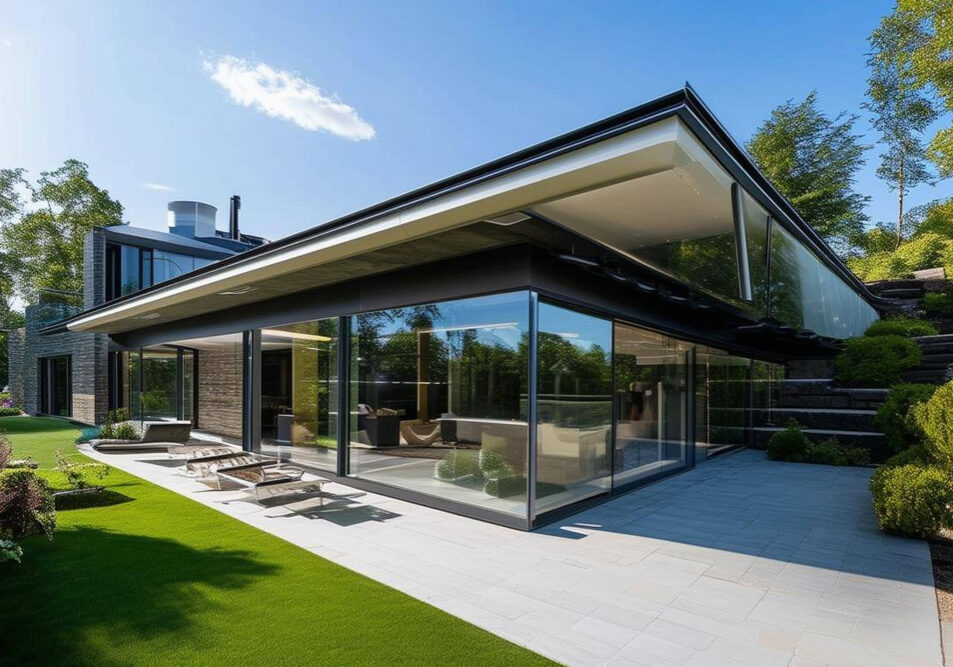What are the Alternatives to Solar Glass?

As our climate warms, architects are increasingly looking at various options to keep our homes and offices cool in the summer.
This is especially important when you consider the difference between comfortable and sweltering is just five degrees.
A popular choice is solar glass, which is a glass treated with a metallic tinted coating to reflect infrared radiation which allows the light to enter the room.
However, it is not to everyone’s taste because it is fixed and therefore you have no control how much light can come into the building; and the tint colours are not to everyone’s taste.
Thankfully, there are many alternative options under the umbrella of solar shading which comply with Building Regulations Part O introduced in 2023 to tackle overheating in buildings.
External Blinds for Solar Shading
Did you know external blinds are more effective than solar glass at reducing temperatures inside?
This depends on the window’s orientation and how dark a shade you choose and, of course, climate, but they can reduce temperatures inside by up to five degrees compared to solar glass’s two degrees reduction.
Our external blinds are very stylish and their special weave means you can still enjoy the world outside when they are pulled down.
They are typically made with an aluminium frame and are adjustable to control the amount of light and heat allowed into the building, needing minimal maintenance unlike air conditioning units.
Brise soleil
Some architects will design and incorporate a brise soleil into a building to reduce heat gain from large windows.
They are built at an angle to deflect the summer sun but allow lower winter sunlight into the building to provide passivhaus solar heating.
Louvres
Louvres are angled slats that are either fixed or hung on the outside of a window and allow for greater air circulation and to keep sunlight out during summer months.
Deep window reveals
A deep window reveal is a window opening that extends further into a wall than normal. Deep reveals can be used to reduce glare, frame views, and add architectural interest.
External overhangs
These are otherwise known as eaves and are horizontal extensions of a roof that extend past the exterior walls of a building. They help protect the home from rain, snow and sunlight.
Awnings
These are fabric or metal coverings that are attached to the outside of a building and extend over any large windows, deck or patio.
They provide protection from the sun in the summer and can help stop your home from overheating.
Internal curtains or blinds
Curtains and internal blinds can block out some sunlight during very hot days but will also block any natural light coming into the house or office and can create a stuffy atmosphere.
Air conditioning
Air conditioning units are far more popular in hotter climates, where temperatures regularly hit the mid-40s.
However, they are very expensive to run compared to external blinds or using an electric fan and can double your energy bills.
They are also really bad for the environment. One air conditioning unit running for an hour creates 0.536kg of CO2 compared to just 0.02kg when using an electric fan for an hour.
In its report The Future of Cooling, the International Energy Agency (IEA), which works with governments around the globe to shape a sustainable future, estimates that worldwide air conditioning units contribute to ten per cent of electricity consumption
And UNICEF estimates that air conditioning units contribute to almost four per cent of the world’s greenhouse gas emissions.
Another cost is ongoing maintenance. Filters clog with dust and need to be cleaned at least every two months and the unit needs a yearly service.
Environmentally Friendly Blinds Advice
If you want any advice or resources on key factors such as cost, look and sustainability of external blinds, then contact our team of experts who are always on hand to help you. Serving prime residential, heritage, commercial and other sectors.



